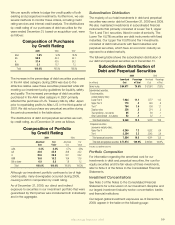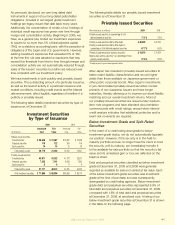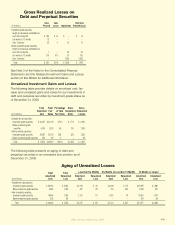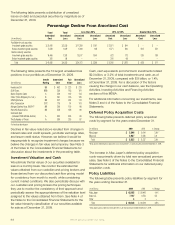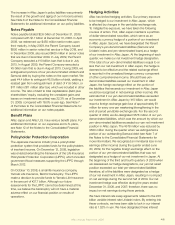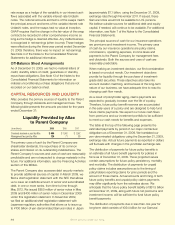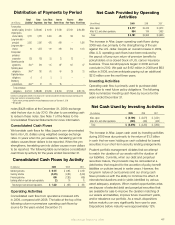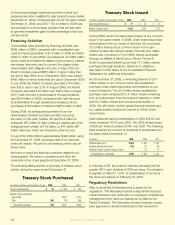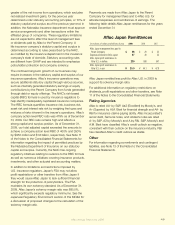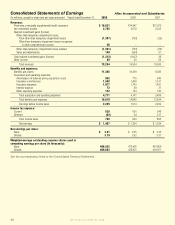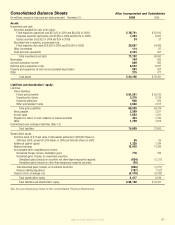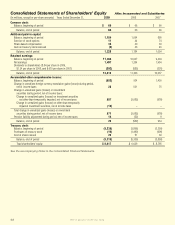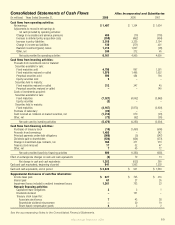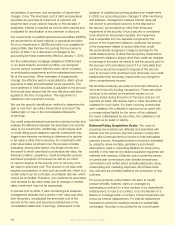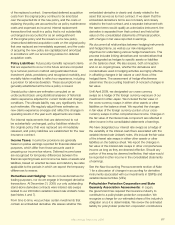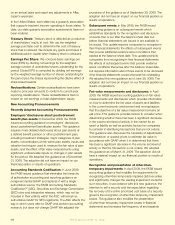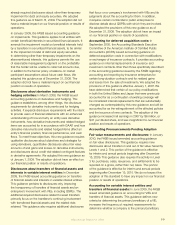Aflac 2009 Annual Report Download - page 53
Download and view the complete annual report
Please find page 53 of the 2009 Aflac annual report below. You can navigate through the pages in the report by either clicking on the pages listed below, or by using the keyword search tool below to find specific information within the annual report.
greater of the net income from operations, which excludes
net realized investment gains, for the previous year
determined under statutory accounting principles, or 10% of
statutory capital and surplus as of the previous year-end. In
addition, the Nebraska insurance department must approve
service arrangements and other transactions within the
afliated group of companies. These regulatory limitations
are not expected to affect the level of management fees
or dividends paid by Aac to the Parent Company. A
life insurance company’s statutory capital and surplus is
determined according to rules prescribed by the NAIC,
as modied by the insurance department in the insurance
company’s state of domicile. Statutory accounting rules
are different from GAAP and are intended to emphasize
policyholder protection and company solvency.
The continued long-term growth of our business may
require increases in the statutory capital and surplus of our
insurance operations. Aac’s insurance operations may
secure additional statutory capital through various sources,
such as internally generated statutory earnings or equity
contributions by the Parent Company from funds generated
through debt or equity offerings. The NAIC’s risk-based
capital (RBC) formula is used by insurance regulators to
help identify inadequately capitalized insurance companies.
The RBC formula quanties insurance risk, business risk,
asset risk and interest rate risk by weighing the types and
mixtures of risks inherent in the insurer’s operations. Aac’s
company action level RBC ratio was 479% as of December
31, 2009. Our RBC ratio remains high and reects a
strong capital and surplus position. As of December 31,
2009, our total adjusted capital exceeded the amounts to
achieve a company action level RBC of 400% and 350%
by $953 million and $1.6 billion, respectively. See Note 11
of the Notes to the Consolidated Financial Statements for
information regarding the impact of permitted practices by
the Nebraska Department of Insurance on our statutory
capital and surplus. Currently, the NAIC has ongoing
regulatory initiatives relating to revisions to the RBC formula
as well as numerous initiatives covering insurance products,
investments, and other actuarial and accounting matters.
In addition to limitations and restrictions imposed by
U.S. insurance regulators, Japan’s FSA may not allow
prot repatriations or other transfers from Aac Japan if
they would cause Aac Japan to lack sufcient nancial
strength for the protection of policyholders. The FSA
maintains its own solvency standard. As of December 31,
2009, Aac Japan’s solvency margin ratio was 885.5%,
which signicantly exceeds regulatory minimums. See the
Japanese Regulatory Environment section of this MD&A for
a discussion of proposed changes to the calculation of the
solvency margin ratio.
Payments are made from Aac Japan to the Parent
Company for management fees and to Aac U.S. for
allocated expenses and remittances of earnings. The
following table details Aac Japan remittances for the years
ended December 31.
Aac Japan remitted less prot to Aac U.S. in 2009 to
support its solvency margin ratio.
For additional information on regulatory restrictions on
dividends, prot repatriations and other transfers, see Note
11 of the Notes to the Consolidated Financial Statements.
Rating Agencies
Aac is rated AA- by S&P, Aa2 (Excellent) by Moody’s, and
A+ (Superior) by A.M. Best for nancial strength and AA- by
R&I for insurance claims-paying ability. Aac Incorporated’s
senior debt, Samurai notes, and Uridashi notes are rated
A- by S&P, A2 by Moody’s and A by R&I. S&P, Moody’s and
A.M. Best have classied Aac’s credit outlook as negative,
consistent with their outlook on the insurance industry. R&I
has classied Aac’s credit outlook as stable.
Other
For information regarding commitments and contingent
liabilities, see Note 13 of the Notes to the Consolidated
Financial Statements.
Aac Japan Remittances
(In millions of dollars and billions of yen)
2009 2008
2007
Aflac Japan management fees paid to
Parent Company $ 26 $ 26 $ 32
Expenses allocated to Aflac Japan 37 36 33
Aflac Japan profit remittances to
Aflac U.S. in dollars 230 598 567
Aflac Japan profit remittances to
Aflac U.S. in yen ¥ 20.0 ¥ 64.1 ¥ 67.8
Aflac Annual Report for 2009 49


